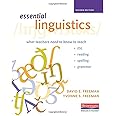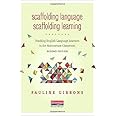This book has great linguistic information, but it simply is not practical and not a good textbook format. The 2 biggest issues are that no key linguistic terms are highlighted (some are italicized but so are many other words for emphasis in a given paragraph) and there is no glossary of terms. For example, under an entire chapter on "English orthography" you don't even get to a decent definition of the term until the 4th page of the chapter. The term is finally italicized, though not in the same sentence as it's definition, and on the same page same section, also these words are italicized: great, grate, through, though, walk. Thus it is easy to see how the actual important term gets lost and is difficult to identify in context.These two things alone, not bolding key terms and having no glossary of terms, make it a thumbs down book in my opinion as a non-fiction resource. It just is not useable as a reference if you cannot quickly look up terms or quickly scan a section for the term or key ideas in context. That makes it the kind of book that you read for a class and then pitch or hope to somehow be able to sell because you know you'll likely never use it again bc it just isn't practical. But I won't get much for reselling bc I have to mark up the book to clarify where the key terms are, so no one wants "used" with markings. Frankly, I think mine is better now that I have markings and someone should pay me more than the list price :-). I have taught for a number of years and returned to school for TESOL, but this is one resource I am not likely to keep or use long term. I wish my professor had chosen a different book. But maybe there just aren't better ones out there?? this one could be a GREAT resource with a major formatting overhaul.Other issues include the end of chapter conclusions are mediocre and end applications are a good concept, as far as a teacher is concerned, creating natural "assignments" for students of this subject matter, somewhat forcing them to go back and sift through all the material to find the key ideas, but would be more practical to just create the charts with summaries of big ideas, theories discussed, etc. if you want to create a valuable resource students want to keep. Cut the busy work and challenge of making students sift through the jargon for the meat.Publishers/authors, if you want to write a text that students of your field want to keep, PROVIDE A GLOSSARY and BOLD TYPE ALL VOCABULARY/KEY TERMS in context and have clear good conclusion summaries of each chapter (visual aids such as charts/diagrams couldn't hurt either, like your application chart idea on p. 50, end of ch 2 that I did myself to try to make sense of all the material, but you could just provide this kind of breakdown!). It also couldn't hurt to add sub points to your very bare-bones table of contents or a "where we're headed" bulleted list at the beginning of each chapter.




